Analyzing Cultural Diversity: A Case Study of INPEX Corporation
VerifiedAdded on 2020/03/04
|14
|3692
|385
Report
AI Summary
This report examines the importance of cultural diversity in today's globalized world, using INPEX Corporation as a case study. It focuses on the economic relationship between Japan and Australia, highlighting how embracing cultural differences has led to significant economic development. The analysis delves into three key aspects: social relationships, power distribution, and social control, and uncertainty. The report utilizes Hofstede's Five Dimensions of Culture to compare and contrast the cultures of Japan and Australia, focusing on power distance, individualism, and uncertainty avoidance. It explores how these cultural differences impact business practices, decision-making, and communication within the multinational corporation. The report concludes by emphasizing the benefits of understanding and embracing cultural diversity for fostering successful international business ventures.

1
INPEX CORPORATION
INPEX CORPORATION
Paraphrase This Document
Need a fresh take? Get an instant paraphrase of this document with our AI Paraphraser
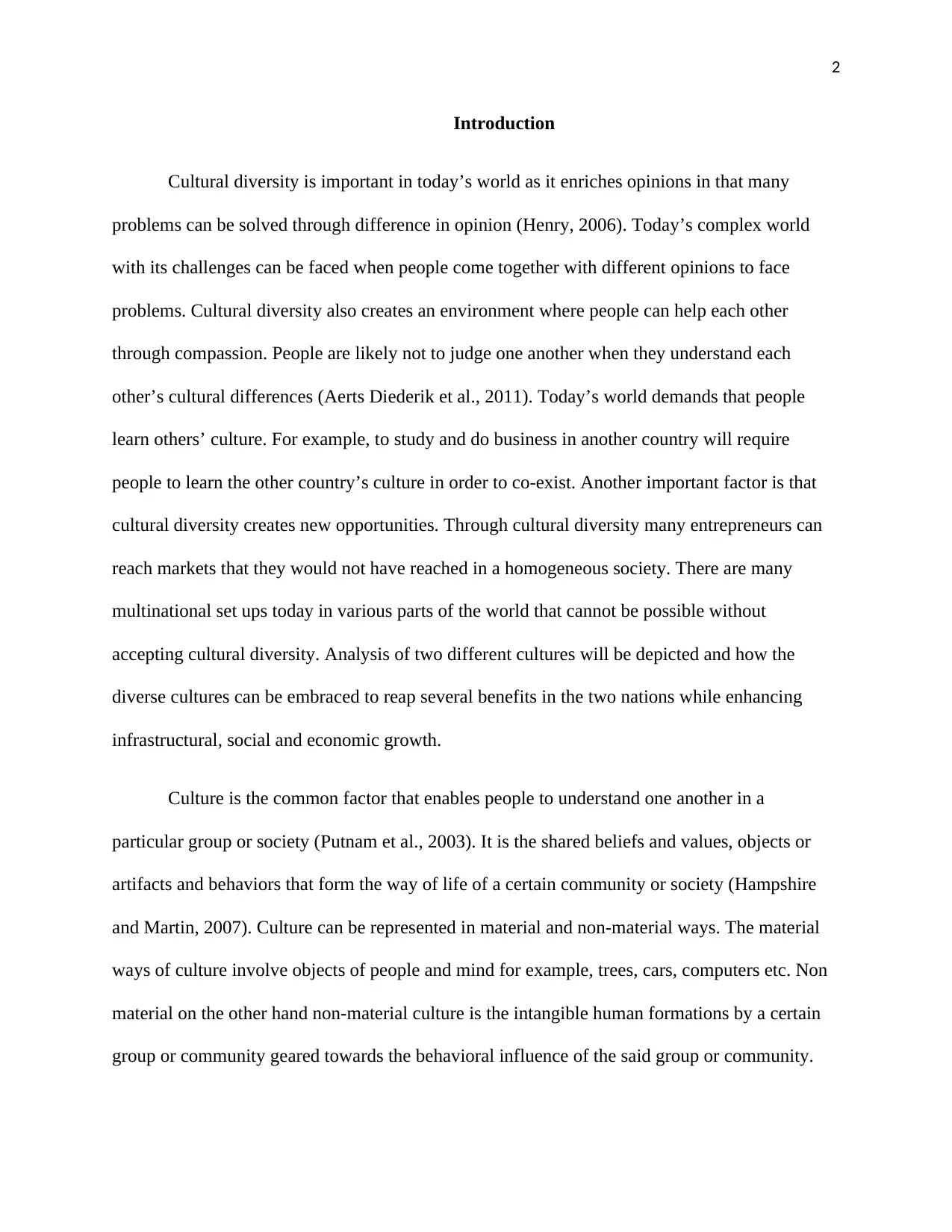
2
Introduction
Cultural diversity is important in today’s world as it enriches opinions in that many
problems can be solved through difference in opinion (Henry, 2006). Today’s complex world
with its challenges can be faced when people come together with different opinions to face
problems. Cultural diversity also creates an environment where people can help each other
through compassion. People are likely not to judge one another when they understand each
other’s cultural differences (Aerts Diederik et al., 2011). Today’s world demands that people
learn others’ culture. For example, to study and do business in another country will require
people to learn the other country’s culture in order to co-exist. Another important factor is that
cultural diversity creates new opportunities. Through cultural diversity many entrepreneurs can
reach markets that they would not have reached in a homogeneous society. There are many
multinational set ups today in various parts of the world that cannot be possible without
accepting cultural diversity. Analysis of two different cultures will be depicted and how the
diverse cultures can be embraced to reap several benefits in the two nations while enhancing
infrastructural, social and economic growth.
Culture is the common factor that enables people to understand one another in a
particular group or society (Putnam et al., 2003). It is the shared beliefs and values, objects or
artifacts and behaviors that form the way of life of a certain community or society (Hampshire
and Martin, 2007). Culture can be represented in material and non-material ways. The material
ways of culture involve objects of people and mind for example, trees, cars, computers etc. Non
material on the other hand non-material culture is the intangible human formations by a certain
group or community geared towards the behavioral influence of the said group or community.
Introduction
Cultural diversity is important in today’s world as it enriches opinions in that many
problems can be solved through difference in opinion (Henry, 2006). Today’s complex world
with its challenges can be faced when people come together with different opinions to face
problems. Cultural diversity also creates an environment where people can help each other
through compassion. People are likely not to judge one another when they understand each
other’s cultural differences (Aerts Diederik et al., 2011). Today’s world demands that people
learn others’ culture. For example, to study and do business in another country will require
people to learn the other country’s culture in order to co-exist. Another important factor is that
cultural diversity creates new opportunities. Through cultural diversity many entrepreneurs can
reach markets that they would not have reached in a homogeneous society. There are many
multinational set ups today in various parts of the world that cannot be possible without
accepting cultural diversity. Analysis of two different cultures will be depicted and how the
diverse cultures can be embraced to reap several benefits in the two nations while enhancing
infrastructural, social and economic growth.
Culture is the common factor that enables people to understand one another in a
particular group or society (Putnam et al., 2003). It is the shared beliefs and values, objects or
artifacts and behaviors that form the way of life of a certain community or society (Hampshire
and Martin, 2007). Culture can be represented in material and non-material ways. The material
ways of culture involve objects of people and mind for example, trees, cars, computers etc. Non
material on the other hand non-material culture is the intangible human formations by a certain
group or community geared towards the behavioral influence of the said group or community.
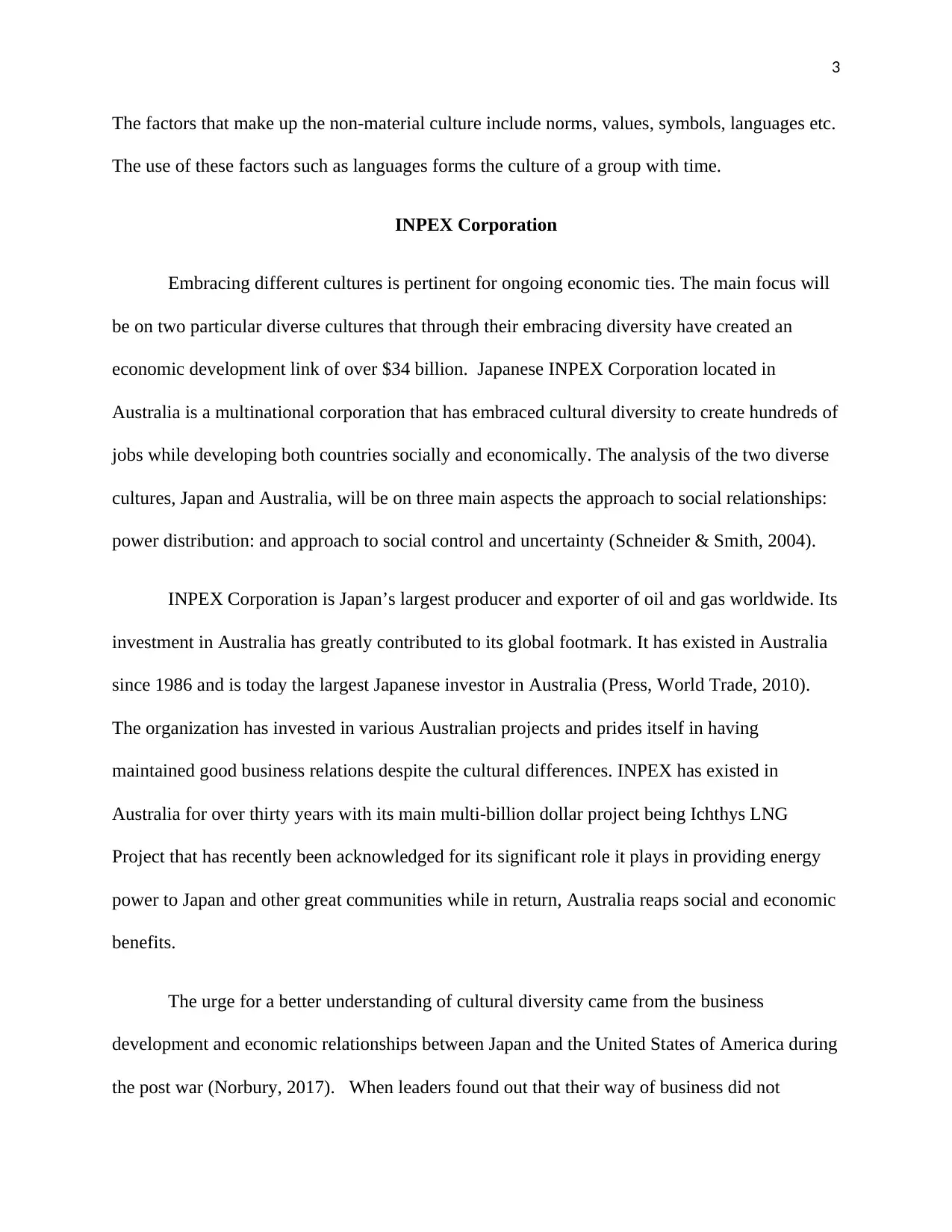
3
The factors that make up the non-material culture include norms, values, symbols, languages etc.
The use of these factors such as languages forms the culture of a group with time.
INPEX Corporation
Embracing different cultures is pertinent for ongoing economic ties. The main focus will
be on two particular diverse cultures that through their embracing diversity have created an
economic development link of over $34 billion. Japanese INPEX Corporation located in
Australia is a multinational corporation that has embraced cultural diversity to create hundreds of
jobs while developing both countries socially and economically. The analysis of the two diverse
cultures, Japan and Australia, will be on three main aspects the approach to social relationships:
power distribution: and approach to social control and uncertainty (Schneider & Smith, 2004).
INPEX Corporation is Japan’s largest producer and exporter of oil and gas worldwide. Its
investment in Australia has greatly contributed to its global footmark. It has existed in Australia
since 1986 and is today the largest Japanese investor in Australia (Press, World Trade, 2010).
The organization has invested in various Australian projects and prides itself in having
maintained good business relations despite the cultural differences. INPEX has existed in
Australia for over thirty years with its main multi-billion dollar project being Ichthys LNG
Project that has recently been acknowledged for its significant role it plays in providing energy
power to Japan and other great communities while in return, Australia reaps social and economic
benefits.
The urge for a better understanding of cultural diversity came from the business
development and economic relationships between Japan and the United States of America during
the post war (Norbury, 2017). When leaders found out that their way of business did not
The factors that make up the non-material culture include norms, values, symbols, languages etc.
The use of these factors such as languages forms the culture of a group with time.
INPEX Corporation
Embracing different cultures is pertinent for ongoing economic ties. The main focus will
be on two particular diverse cultures that through their embracing diversity have created an
economic development link of over $34 billion. Japanese INPEX Corporation located in
Australia is a multinational corporation that has embraced cultural diversity to create hundreds of
jobs while developing both countries socially and economically. The analysis of the two diverse
cultures, Japan and Australia, will be on three main aspects the approach to social relationships:
power distribution: and approach to social control and uncertainty (Schneider & Smith, 2004).
INPEX Corporation is Japan’s largest producer and exporter of oil and gas worldwide. Its
investment in Australia has greatly contributed to its global footmark. It has existed in Australia
since 1986 and is today the largest Japanese investor in Australia (Press, World Trade, 2010).
The organization has invested in various Australian projects and prides itself in having
maintained good business relations despite the cultural differences. INPEX has existed in
Australia for over thirty years with its main multi-billion dollar project being Ichthys LNG
Project that has recently been acknowledged for its significant role it plays in providing energy
power to Japan and other great communities while in return, Australia reaps social and economic
benefits.
The urge for a better understanding of cultural diversity came from the business
development and economic relationships between Japan and the United States of America during
the post war (Norbury, 2017). When leaders found out that their way of business did not
⊘ This is a preview!⊘
Do you want full access?
Subscribe today to unlock all pages.

Trusted by 1+ million students worldwide
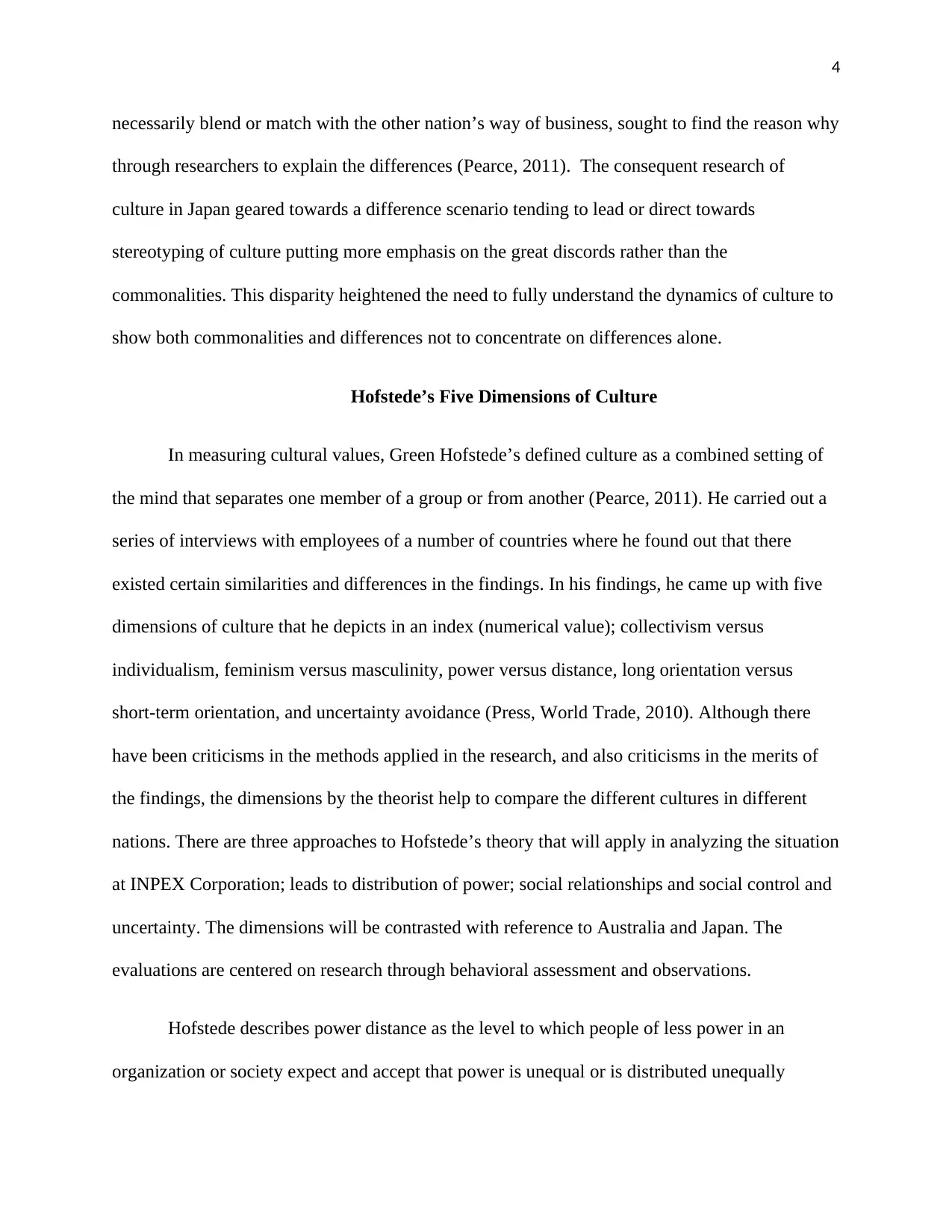
4
necessarily blend or match with the other nation’s way of business, sought to find the reason why
through researchers to explain the differences (Pearce, 2011). The consequent research of
culture in Japan geared towards a difference scenario tending to lead or direct towards
stereotyping of culture putting more emphasis on the great discords rather than the
commonalities. This disparity heightened the need to fully understand the dynamics of culture to
show both commonalities and differences not to concentrate on differences alone.
Hofstede’s Five Dimensions of Culture
In measuring cultural values, Green Hofstede’s defined culture as a combined setting of
the mind that separates one member of a group or from another (Pearce, 2011). He carried out a
series of interviews with employees of a number of countries where he found out that there
existed certain similarities and differences in the findings. In his findings, he came up with five
dimensions of culture that he depicts in an index (numerical value); collectivism versus
individualism, feminism versus masculinity, power versus distance, long orientation versus
short-term orientation, and uncertainty avoidance (Press, World Trade, 2010). Although there
have been criticisms in the methods applied in the research, and also criticisms in the merits of
the findings, the dimensions by the theorist help to compare the different cultures in different
nations. There are three approaches to Hofstede’s theory that will apply in analyzing the situation
at INPEX Corporation; leads to distribution of power; social relationships and social control and
uncertainty. The dimensions will be contrasted with reference to Australia and Japan. The
evaluations are centered on research through behavioral assessment and observations.
Hofstede describes power distance as the level to which people of less power in an
organization or society expect and accept that power is unequal or is distributed unequally
necessarily blend or match with the other nation’s way of business, sought to find the reason why
through researchers to explain the differences (Pearce, 2011). The consequent research of
culture in Japan geared towards a difference scenario tending to lead or direct towards
stereotyping of culture putting more emphasis on the great discords rather than the
commonalities. This disparity heightened the need to fully understand the dynamics of culture to
show both commonalities and differences not to concentrate on differences alone.
Hofstede’s Five Dimensions of Culture
In measuring cultural values, Green Hofstede’s defined culture as a combined setting of
the mind that separates one member of a group or from another (Pearce, 2011). He carried out a
series of interviews with employees of a number of countries where he found out that there
existed certain similarities and differences in the findings. In his findings, he came up with five
dimensions of culture that he depicts in an index (numerical value); collectivism versus
individualism, feminism versus masculinity, power versus distance, long orientation versus
short-term orientation, and uncertainty avoidance (Press, World Trade, 2010). Although there
have been criticisms in the methods applied in the research, and also criticisms in the merits of
the findings, the dimensions by the theorist help to compare the different cultures in different
nations. There are three approaches to Hofstede’s theory that will apply in analyzing the situation
at INPEX Corporation; leads to distribution of power; social relationships and social control and
uncertainty. The dimensions will be contrasted with reference to Australia and Japan. The
evaluations are centered on research through behavioral assessment and observations.
Hofstede describes power distance as the level to which people of less power in an
organization or society expect and accept that power is unequal or is distributed unequally
Paraphrase This Document
Need a fresh take? Get an instant paraphrase of this document with our AI Paraphraser
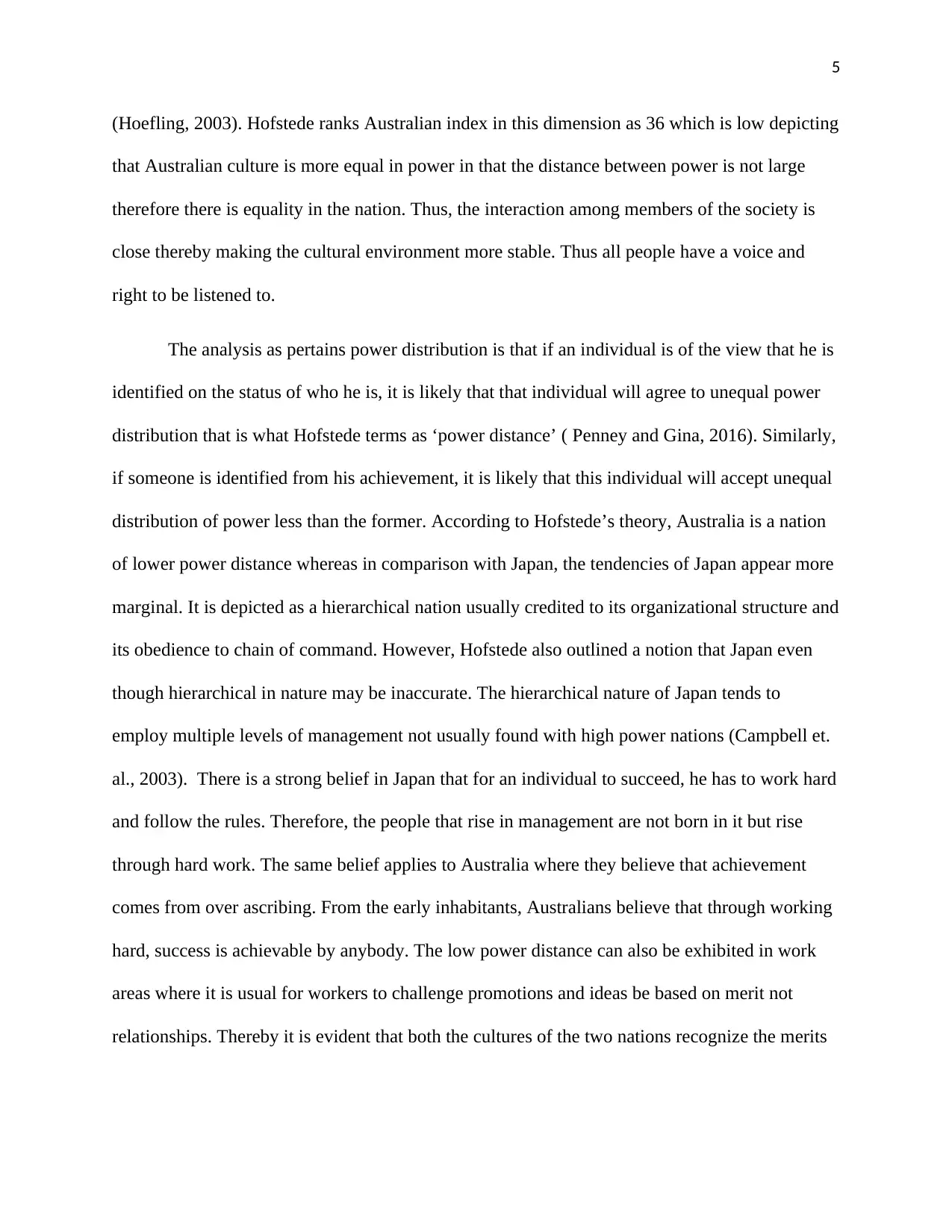
5
(Hoefling, 2003). Hofstede ranks Australian index in this dimension as 36 which is low depicting
that Australian culture is more equal in power in that the distance between power is not large
therefore there is equality in the nation. Thus, the interaction among members of the society is
close thereby making the cultural environment more stable. Thus all people have a voice and
right to be listened to.
The analysis as pertains power distribution is that if an individual is of the view that he is
identified on the status of who he is, it is likely that that individual will agree to unequal power
distribution that is what Hofstede terms as ‘power distance’ ( Penney and Gina, 2016). Similarly,
if someone is identified from his achievement, it is likely that this individual will accept unequal
distribution of power less than the former. According to Hofstede’s theory, Australia is a nation
of lower power distance whereas in comparison with Japan, the tendencies of Japan appear more
marginal. It is depicted as a hierarchical nation usually credited to its organizational structure and
its obedience to chain of command. However, Hofstede also outlined a notion that Japan even
though hierarchical in nature may be inaccurate. The hierarchical nature of Japan tends to
employ multiple levels of management not usually found with high power nations (Campbell et.
al., 2003). There is a strong belief in Japan that for an individual to succeed, he has to work hard
and follow the rules. Therefore, the people that rise in management are not born in it but rise
through hard work. The same belief applies to Australia where they believe that achievement
comes from over ascribing. From the early inhabitants, Australians believe that through working
hard, success is achievable by anybody. The low power distance can also be exhibited in work
areas where it is usual for workers to challenge promotions and ideas be based on merit not
relationships. Thereby it is evident that both the cultures of the two nations recognize the merits
(Hoefling, 2003). Hofstede ranks Australian index in this dimension as 36 which is low depicting
that Australian culture is more equal in power in that the distance between power is not large
therefore there is equality in the nation. Thus, the interaction among members of the society is
close thereby making the cultural environment more stable. Thus all people have a voice and
right to be listened to.
The analysis as pertains power distribution is that if an individual is of the view that he is
identified on the status of who he is, it is likely that that individual will agree to unequal power
distribution that is what Hofstede terms as ‘power distance’ ( Penney and Gina, 2016). Similarly,
if someone is identified from his achievement, it is likely that this individual will accept unequal
distribution of power less than the former. According to Hofstede’s theory, Australia is a nation
of lower power distance whereas in comparison with Japan, the tendencies of Japan appear more
marginal. It is depicted as a hierarchical nation usually credited to its organizational structure and
its obedience to chain of command. However, Hofstede also outlined a notion that Japan even
though hierarchical in nature may be inaccurate. The hierarchical nature of Japan tends to
employ multiple levels of management not usually found with high power nations (Campbell et.
al., 2003). There is a strong belief in Japan that for an individual to succeed, he has to work hard
and follow the rules. Therefore, the people that rise in management are not born in it but rise
through hard work. The same belief applies to Australia where they believe that achievement
comes from over ascribing. From the early inhabitants, Australians believe that through working
hard, success is achievable by anybody. The low power distance can also be exhibited in work
areas where it is usual for workers to challenge promotions and ideas be based on merit not
relationships. Thereby it is evident that both the cultures of the two nations recognize the merits
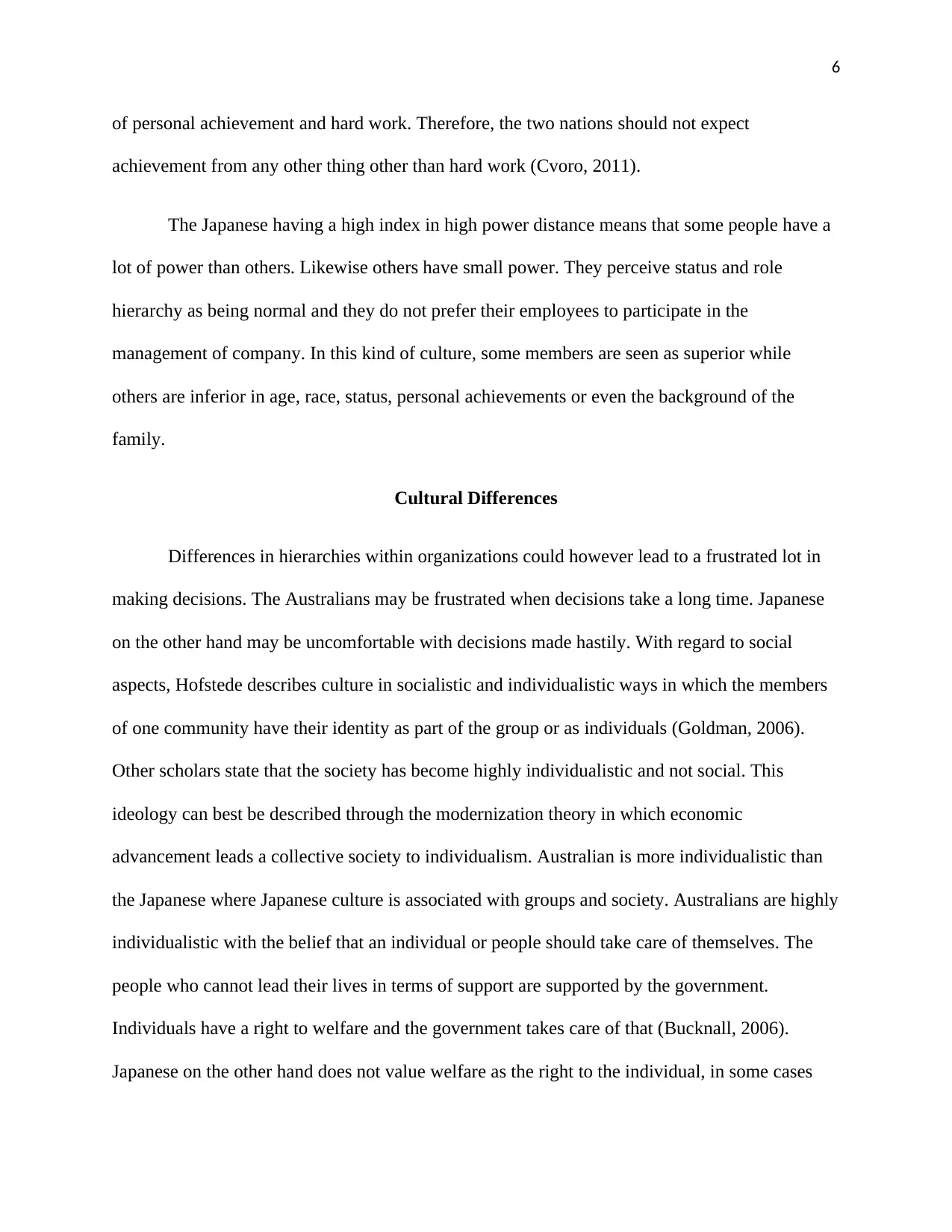
6
of personal achievement and hard work. Therefore, the two nations should not expect
achievement from any other thing other than hard work (Cvoro, 2011).
The Japanese having a high index in high power distance means that some people have a
lot of power than others. Likewise others have small power. They perceive status and role
hierarchy as being normal and they do not prefer their employees to participate in the
management of company. In this kind of culture, some members are seen as superior while
others are inferior in age, race, status, personal achievements or even the background of the
family.
Cultural Differences
Differences in hierarchies within organizations could however lead to a frustrated lot in
making decisions. The Australians may be frustrated when decisions take a long time. Japanese
on the other hand may be uncomfortable with decisions made hastily. With regard to social
aspects, Hofstede describes culture in socialistic and individualistic ways in which the members
of one community have their identity as part of the group or as individuals (Goldman, 2006).
Other scholars state that the society has become highly individualistic and not social. This
ideology can best be described through the modernization theory in which economic
advancement leads a collective society to individualism. Australian is more individualistic than
the Japanese where Japanese culture is associated with groups and society. Australians are highly
individualistic with the belief that an individual or people should take care of themselves. The
people who cannot lead their lives in terms of support are supported by the government.
Individuals have a right to welfare and the government takes care of that (Bucknall, 2006).
Japanese on the other hand does not value welfare as the right to the individual, in some cases
of personal achievement and hard work. Therefore, the two nations should not expect
achievement from any other thing other than hard work (Cvoro, 2011).
The Japanese having a high index in high power distance means that some people have a
lot of power than others. Likewise others have small power. They perceive status and role
hierarchy as being normal and they do not prefer their employees to participate in the
management of company. In this kind of culture, some members are seen as superior while
others are inferior in age, race, status, personal achievements or even the background of the
family.
Cultural Differences
Differences in hierarchies within organizations could however lead to a frustrated lot in
making decisions. The Australians may be frustrated when decisions take a long time. Japanese
on the other hand may be uncomfortable with decisions made hastily. With regard to social
aspects, Hofstede describes culture in socialistic and individualistic ways in which the members
of one community have their identity as part of the group or as individuals (Goldman, 2006).
Other scholars state that the society has become highly individualistic and not social. This
ideology can best be described through the modernization theory in which economic
advancement leads a collective society to individualism. Australian is more individualistic than
the Japanese where Japanese culture is associated with groups and society. Australians are highly
individualistic with the belief that an individual or people should take care of themselves. The
people who cannot lead their lives in terms of support are supported by the government.
Individuals have a right to welfare and the government takes care of that (Bucknall, 2006).
Japanese on the other hand does not value welfare as the right to the individual, in some cases
⊘ This is a preview!⊘
Do you want full access?
Subscribe today to unlock all pages.

Trusted by 1+ million students worldwide
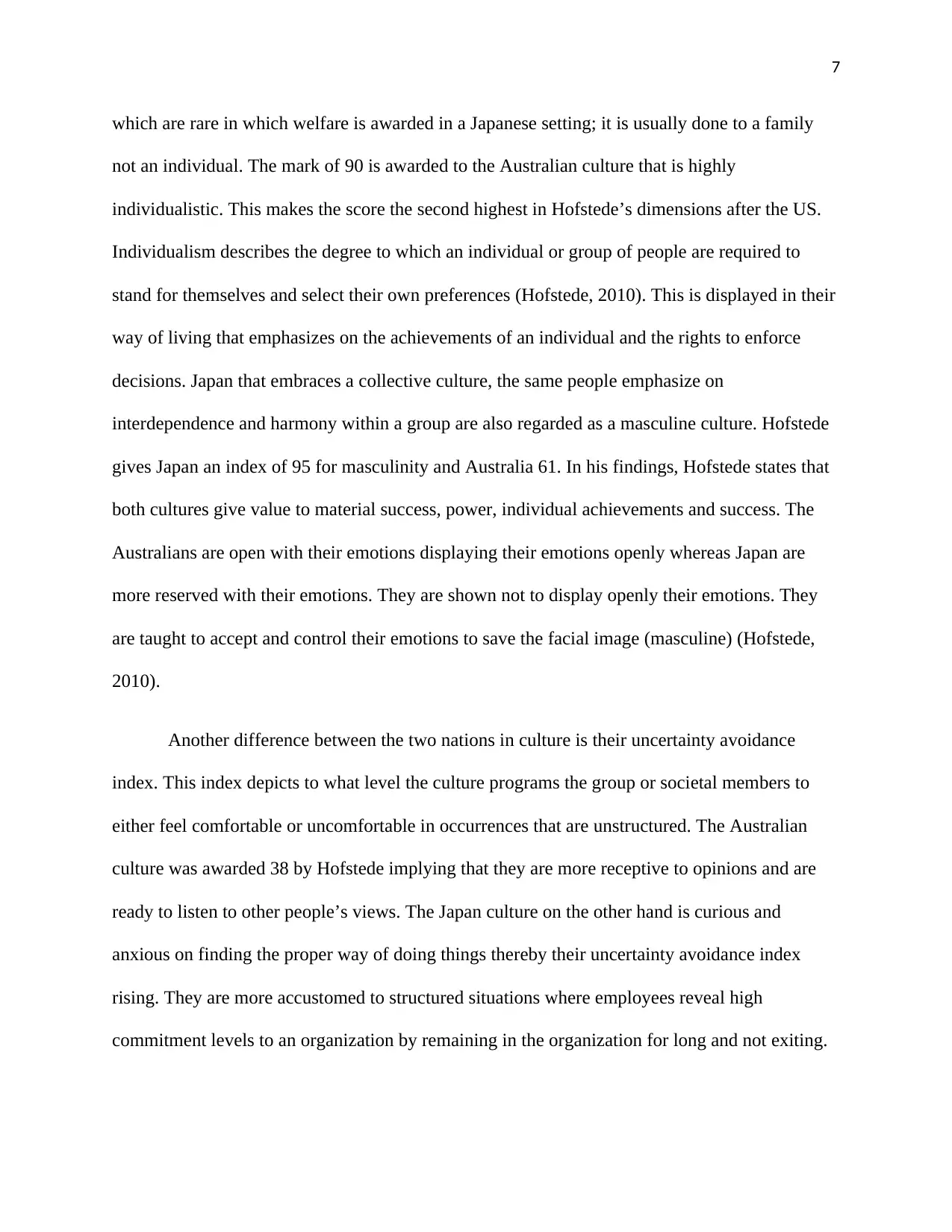
7
which are rare in which welfare is awarded in a Japanese setting; it is usually done to a family
not an individual. The mark of 90 is awarded to the Australian culture that is highly
individualistic. This makes the score the second highest in Hofstede’s dimensions after the US.
Individualism describes the degree to which an individual or group of people are required to
stand for themselves and select their own preferences (Hofstede, 2010). This is displayed in their
way of living that emphasizes on the achievements of an individual and the rights to enforce
decisions. Japan that embraces a collective culture, the same people emphasize on
interdependence and harmony within a group are also regarded as a masculine culture. Hofstede
gives Japan an index of 95 for masculinity and Australia 61. In his findings, Hofstede states that
both cultures give value to material success, power, individual achievements and success. The
Australians are open with their emotions displaying their emotions openly whereas Japan are
more reserved with their emotions. They are shown not to display openly their emotions. They
are taught to accept and control their emotions to save the facial image (masculine) (Hofstede,
2010).
Another difference between the two nations in culture is their uncertainty avoidance
index. This index depicts to what level the culture programs the group or societal members to
either feel comfortable or uncomfortable in occurrences that are unstructured. The Australian
culture was awarded 38 by Hofstede implying that they are more receptive to opinions and are
ready to listen to other people’s views. The Japan culture on the other hand is curious and
anxious on finding the proper way of doing things thereby their uncertainty avoidance index
rising. They are more accustomed to structured situations where employees reveal high
commitment levels to an organization by remaining in the organization for long and not exiting.
which are rare in which welfare is awarded in a Japanese setting; it is usually done to a family
not an individual. The mark of 90 is awarded to the Australian culture that is highly
individualistic. This makes the score the second highest in Hofstede’s dimensions after the US.
Individualism describes the degree to which an individual or group of people are required to
stand for themselves and select their own preferences (Hofstede, 2010). This is displayed in their
way of living that emphasizes on the achievements of an individual and the rights to enforce
decisions. Japan that embraces a collective culture, the same people emphasize on
interdependence and harmony within a group are also regarded as a masculine culture. Hofstede
gives Japan an index of 95 for masculinity and Australia 61. In his findings, Hofstede states that
both cultures give value to material success, power, individual achievements and success. The
Australians are open with their emotions displaying their emotions openly whereas Japan are
more reserved with their emotions. They are shown not to display openly their emotions. They
are taught to accept and control their emotions to save the facial image (masculine) (Hofstede,
2010).
Another difference between the two nations in culture is their uncertainty avoidance
index. This index depicts to what level the culture programs the group or societal members to
either feel comfortable or uncomfortable in occurrences that are unstructured. The Australian
culture was awarded 38 by Hofstede implying that they are more receptive to opinions and are
ready to listen to other people’s views. The Japan culture on the other hand is curious and
anxious on finding the proper way of doing things thereby their uncertainty avoidance index
rising. They are more accustomed to structured situations where employees reveal high
commitment levels to an organization by remaining in the organization for long and not exiting.
Paraphrase This Document
Need a fresh take? Get an instant paraphrase of this document with our AI Paraphraser
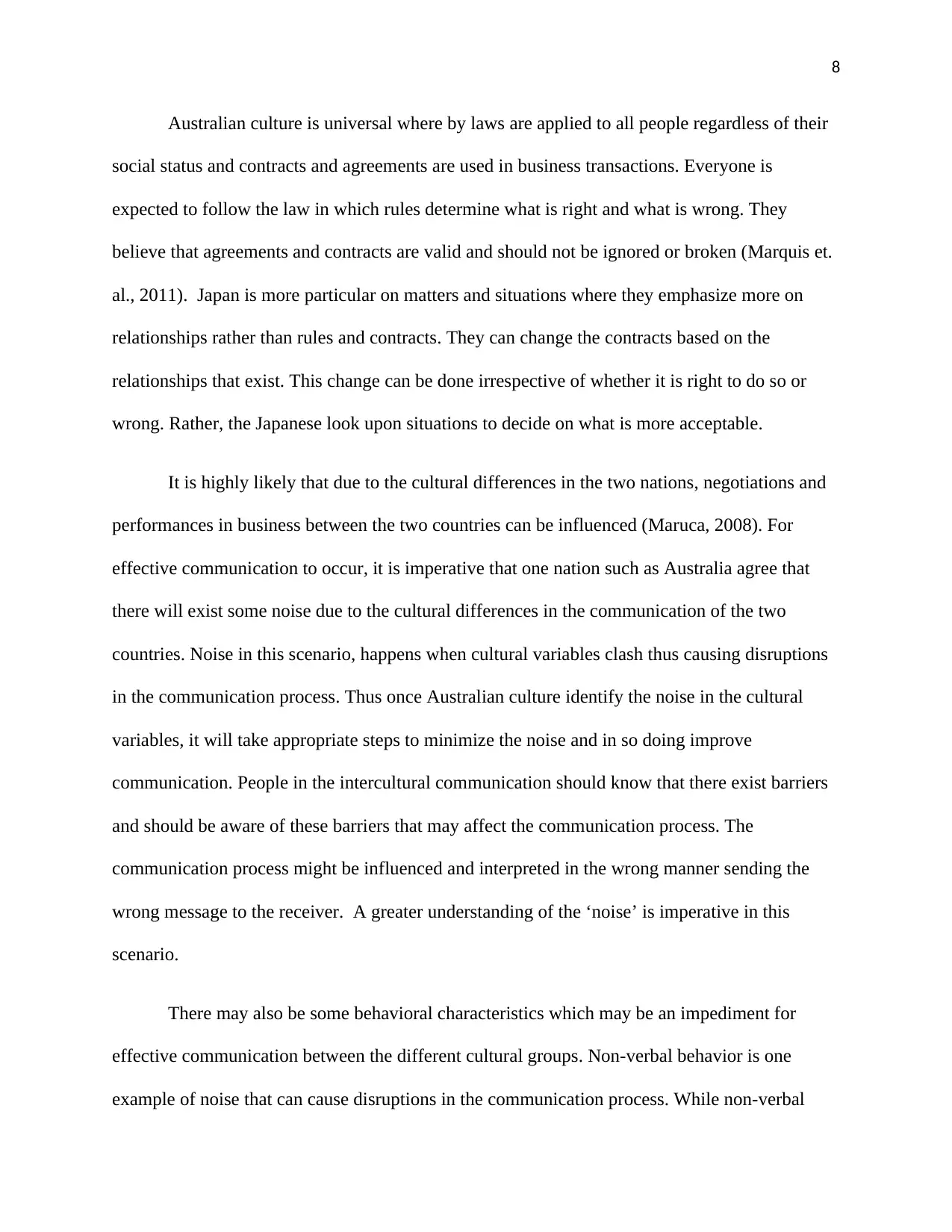
8
Australian culture is universal where by laws are applied to all people regardless of their
social status and contracts and agreements are used in business transactions. Everyone is
expected to follow the law in which rules determine what is right and what is wrong. They
believe that agreements and contracts are valid and should not be ignored or broken (Marquis et.
al., 2011). Japan is more particular on matters and situations where they emphasize more on
relationships rather than rules and contracts. They can change the contracts based on the
relationships that exist. This change can be done irrespective of whether it is right to do so or
wrong. Rather, the Japanese look upon situations to decide on what is more acceptable.
It is highly likely that due to the cultural differences in the two nations, negotiations and
performances in business between the two countries can be influenced (Maruca, 2008). For
effective communication to occur, it is imperative that one nation such as Australia agree that
there will exist some noise due to the cultural differences in the communication of the two
countries. Noise in this scenario, happens when cultural variables clash thus causing disruptions
in the communication process. Thus once Australian culture identify the noise in the cultural
variables, it will take appropriate steps to minimize the noise and in so doing improve
communication. People in the intercultural communication should know that there exist barriers
and should be aware of these barriers that may affect the communication process. The
communication process might be influenced and interpreted in the wrong manner sending the
wrong message to the receiver. A greater understanding of the ‘noise’ is imperative in this
scenario.
There may also be some behavioral characteristics which may be an impediment for
effective communication between the different cultural groups. Non-verbal behavior is one
example of noise that can cause disruptions in the communication process. While non-verbal
Australian culture is universal where by laws are applied to all people regardless of their
social status and contracts and agreements are used in business transactions. Everyone is
expected to follow the law in which rules determine what is right and what is wrong. They
believe that agreements and contracts are valid and should not be ignored or broken (Marquis et.
al., 2011). Japan is more particular on matters and situations where they emphasize more on
relationships rather than rules and contracts. They can change the contracts based on the
relationships that exist. This change can be done irrespective of whether it is right to do so or
wrong. Rather, the Japanese look upon situations to decide on what is more acceptable.
It is highly likely that due to the cultural differences in the two nations, negotiations and
performances in business between the two countries can be influenced (Maruca, 2008). For
effective communication to occur, it is imperative that one nation such as Australia agree that
there will exist some noise due to the cultural differences in the communication of the two
countries. Noise in this scenario, happens when cultural variables clash thus causing disruptions
in the communication process. Thus once Australian culture identify the noise in the cultural
variables, it will take appropriate steps to minimize the noise and in so doing improve
communication. People in the intercultural communication should know that there exist barriers
and should be aware of these barriers that may affect the communication process. The
communication process might be influenced and interpreted in the wrong manner sending the
wrong message to the receiver. A greater understanding of the ‘noise’ is imperative in this
scenario.
There may also be some behavioral characteristics which may be an impediment for
effective communication between the different cultural groups. Non-verbal behavior is one
example of noise that can cause disruptions in the communication process. While non-verbal
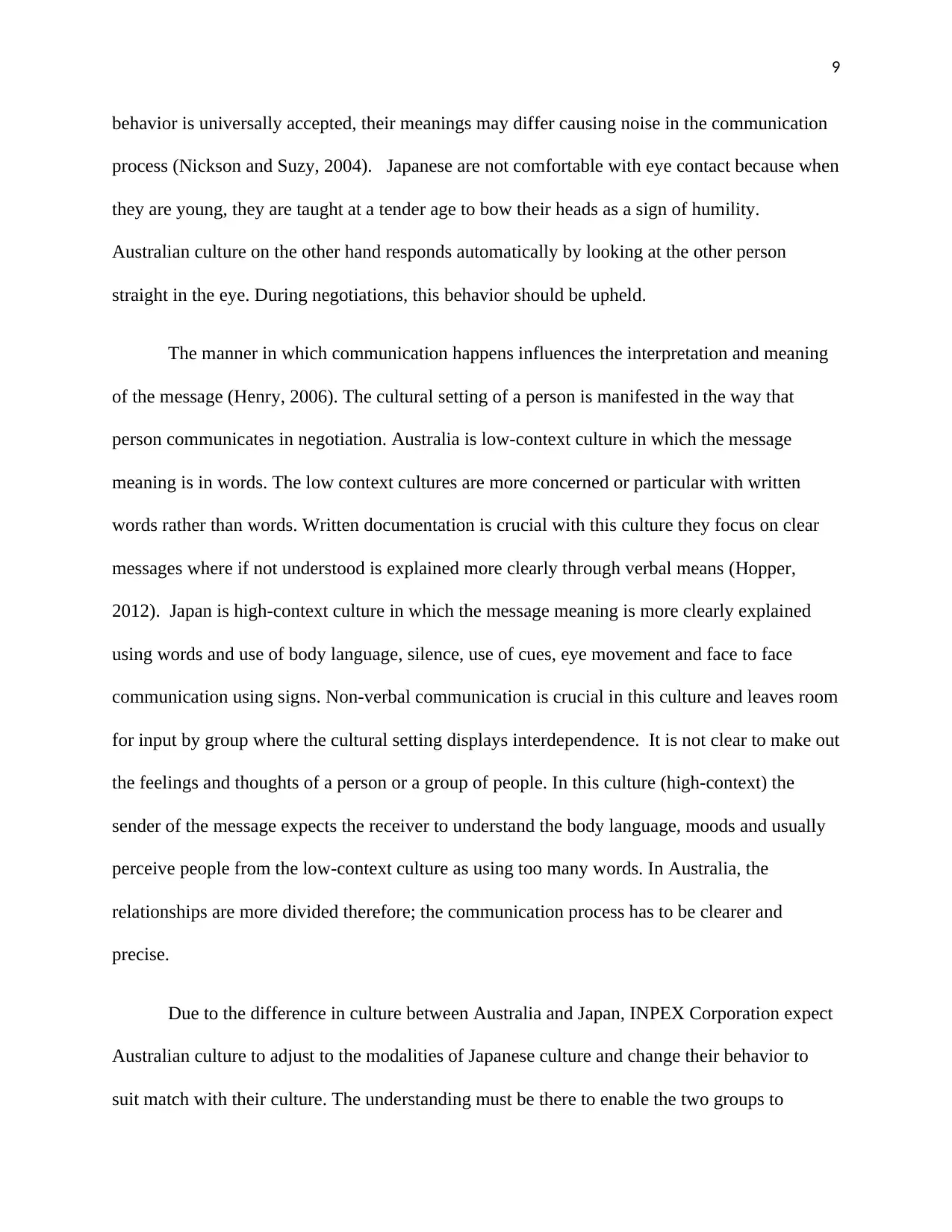
9
behavior is universally accepted, their meanings may differ causing noise in the communication
process (Nickson and Suzy, 2004). Japanese are not comfortable with eye contact because when
they are young, they are taught at a tender age to bow their heads as a sign of humility.
Australian culture on the other hand responds automatically by looking at the other person
straight in the eye. During negotiations, this behavior should be upheld.
The manner in which communication happens influences the interpretation and meaning
of the message (Henry, 2006). The cultural setting of a person is manifested in the way that
person communicates in negotiation. Australia is low-context culture in which the message
meaning is in words. The low context cultures are more concerned or particular with written
words rather than words. Written documentation is crucial with this culture they focus on clear
messages where if not understood is explained more clearly through verbal means (Hopper,
2012). Japan is high-context culture in which the message meaning is more clearly explained
using words and use of body language, silence, use of cues, eye movement and face to face
communication using signs. Non-verbal communication is crucial in this culture and leaves room
for input by group where the cultural setting displays interdependence. It is not clear to make out
the feelings and thoughts of a person or a group of people. In this culture (high-context) the
sender of the message expects the receiver to understand the body language, moods and usually
perceive people from the low-context culture as using too many words. In Australia, the
relationships are more divided therefore; the communication process has to be clearer and
precise.
Due to the difference in culture between Australia and Japan, INPEX Corporation expect
Australian culture to adjust to the modalities of Japanese culture and change their behavior to
suit match with their culture. The understanding must be there to enable the two groups to
behavior is universally accepted, their meanings may differ causing noise in the communication
process (Nickson and Suzy, 2004). Japanese are not comfortable with eye contact because when
they are young, they are taught at a tender age to bow their heads as a sign of humility.
Australian culture on the other hand responds automatically by looking at the other person
straight in the eye. During negotiations, this behavior should be upheld.
The manner in which communication happens influences the interpretation and meaning
of the message (Henry, 2006). The cultural setting of a person is manifested in the way that
person communicates in negotiation. Australia is low-context culture in which the message
meaning is in words. The low context cultures are more concerned or particular with written
words rather than words. Written documentation is crucial with this culture they focus on clear
messages where if not understood is explained more clearly through verbal means (Hopper,
2012). Japan is high-context culture in which the message meaning is more clearly explained
using words and use of body language, silence, use of cues, eye movement and face to face
communication using signs. Non-verbal communication is crucial in this culture and leaves room
for input by group where the cultural setting displays interdependence. It is not clear to make out
the feelings and thoughts of a person or a group of people. In this culture (high-context) the
sender of the message expects the receiver to understand the body language, moods and usually
perceive people from the low-context culture as using too many words. In Australia, the
relationships are more divided therefore; the communication process has to be clearer and
precise.
Due to the difference in culture between Australia and Japan, INPEX Corporation expect
Australian culture to adjust to the modalities of Japanese culture and change their behavior to
suit match with their culture. The understanding must be there to enable the two groups to
⊘ This is a preview!⊘
Do you want full access?
Subscribe today to unlock all pages.

Trusted by 1+ million students worldwide
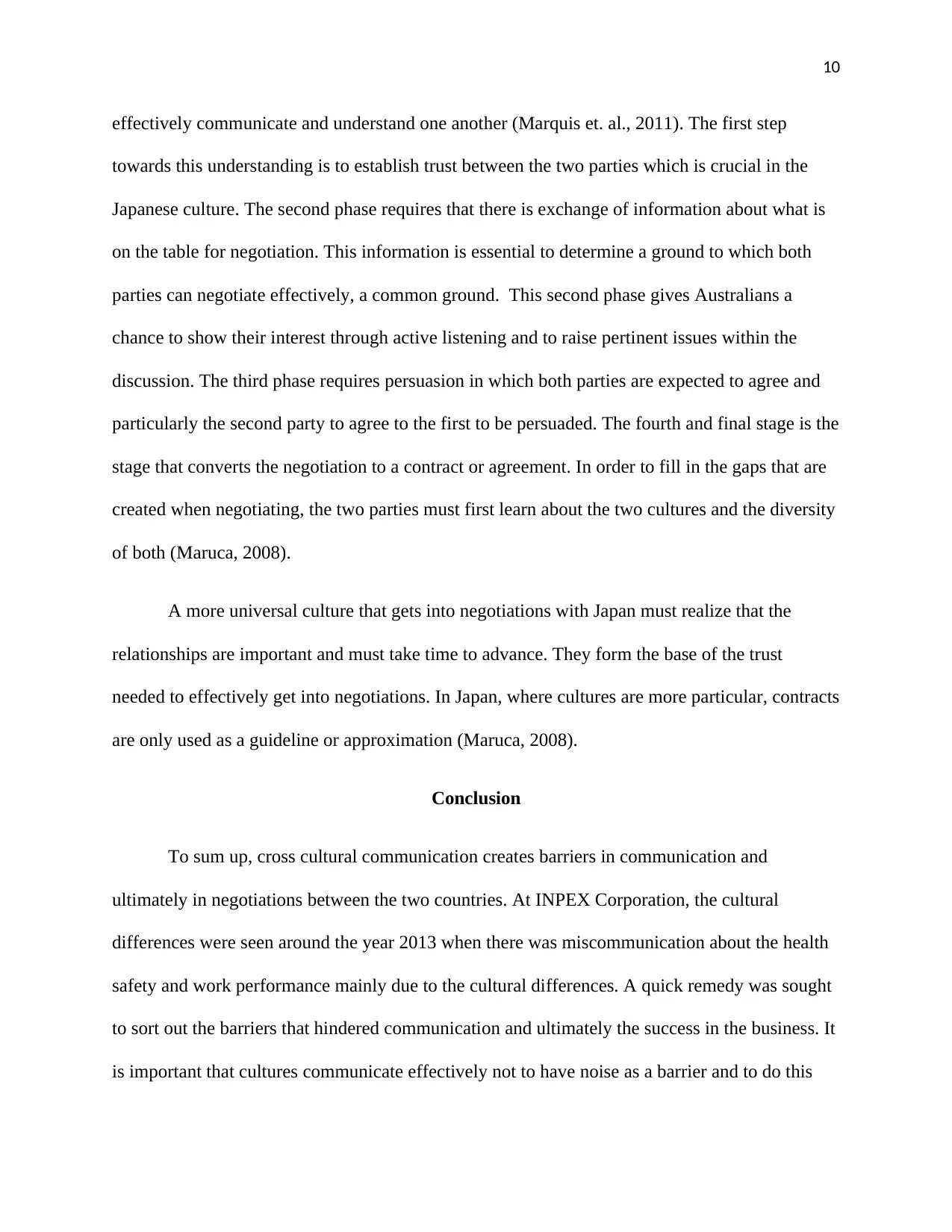
10
effectively communicate and understand one another (Marquis et. al., 2011). The first step
towards this understanding is to establish trust between the two parties which is crucial in the
Japanese culture. The second phase requires that there is exchange of information about what is
on the table for negotiation. This information is essential to determine a ground to which both
parties can negotiate effectively, a common ground. This second phase gives Australians a
chance to show their interest through active listening and to raise pertinent issues within the
discussion. The third phase requires persuasion in which both parties are expected to agree and
particularly the second party to agree to the first to be persuaded. The fourth and final stage is the
stage that converts the negotiation to a contract or agreement. In order to fill in the gaps that are
created when negotiating, the two parties must first learn about the two cultures and the diversity
of both (Maruca, 2008).
A more universal culture that gets into negotiations with Japan must realize that the
relationships are important and must take time to advance. They form the base of the trust
needed to effectively get into negotiations. In Japan, where cultures are more particular, contracts
are only used as a guideline or approximation (Maruca, 2008).
Conclusion
To sum up, cross cultural communication creates barriers in communication and
ultimately in negotiations between the two countries. At INPEX Corporation, the cultural
differences were seen around the year 2013 when there was miscommunication about the health
safety and work performance mainly due to the cultural differences. A quick remedy was sought
to sort out the barriers that hindered communication and ultimately the success in the business. It
is important that cultures communicate effectively not to have noise as a barrier and to do this
effectively communicate and understand one another (Marquis et. al., 2011). The first step
towards this understanding is to establish trust between the two parties which is crucial in the
Japanese culture. The second phase requires that there is exchange of information about what is
on the table for negotiation. This information is essential to determine a ground to which both
parties can negotiate effectively, a common ground. This second phase gives Australians a
chance to show their interest through active listening and to raise pertinent issues within the
discussion. The third phase requires persuasion in which both parties are expected to agree and
particularly the second party to agree to the first to be persuaded. The fourth and final stage is the
stage that converts the negotiation to a contract or agreement. In order to fill in the gaps that are
created when negotiating, the two parties must first learn about the two cultures and the diversity
of both (Maruca, 2008).
A more universal culture that gets into negotiations with Japan must realize that the
relationships are important and must take time to advance. They form the base of the trust
needed to effectively get into negotiations. In Japan, where cultures are more particular, contracts
are only used as a guideline or approximation (Maruca, 2008).
Conclusion
To sum up, cross cultural communication creates barriers in communication and
ultimately in negotiations between the two countries. At INPEX Corporation, the cultural
differences were seen around the year 2013 when there was miscommunication about the health
safety and work performance mainly due to the cultural differences. A quick remedy was sought
to sort out the barriers that hindered communication and ultimately the success in the business. It
is important that cultures communicate effectively not to have noise as a barrier and to do this
Paraphrase This Document
Need a fresh take? Get an instant paraphrase of this document with our AI Paraphraser

11
one way to effectively do this is by understanding the different cultures and trying to fit into
them. Japanese culture should be dug further or explored. Likewise, Australian culture should
equally be explored by Japan. Relationships and the basis to which business are done and for
business to prosper, both parties have to communicate and accept the diversity.
one way to effectively do this is by understanding the different cultures and trying to fit into
them. Japanese culture should be dug further or explored. Likewise, Australian culture should
equally be explored by Japan. Relationships and the basis to which business are done and for
business to prosper, both parties have to communicate and accept the diversity.
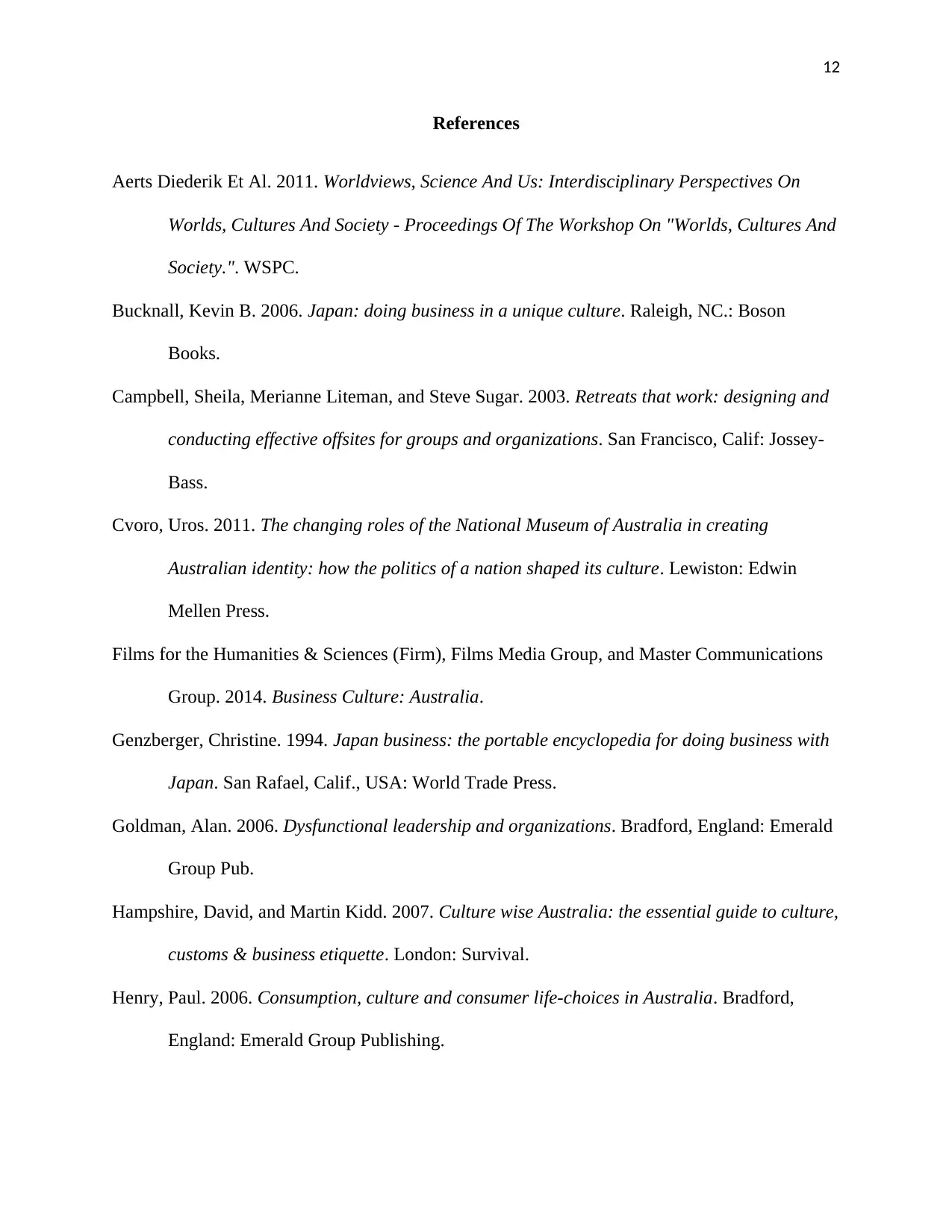
12
References
Aerts Diederik Et Al. 2011. Worldviews, Science And Us: Interdisciplinary Perspectives On
Worlds, Cultures And Society - Proceedings Of The Workshop On "Worlds, Cultures And
Society.". WSPC.
Bucknall, Kevin B. 2006. Japan: doing business in a unique culture. Raleigh, NC.: Boson
Books.
Campbell, Sheila, Merianne Liteman, and Steve Sugar. 2003. Retreats that work: designing and
conducting effective offsites for groups and organizations. San Francisco, Calif: Jossey-
Bass.
Cvoro, Uros. 2011. The changing roles of the National Museum of Australia in creating
Australian identity: how the politics of a nation shaped its culture. Lewiston: Edwin
Mellen Press.
Films for the Humanities & Sciences (Firm), Films Media Group, and Master Communications
Group. 2014. Business Culture: Australia.
Genzberger, Christine. 1994. Japan business: the portable encyclopedia for doing business with
Japan. San Rafael, Calif., USA: World Trade Press.
Goldman, Alan. 2006. Dysfunctional leadership and organizations. Bradford, England: Emerald
Group Pub.
Hampshire, David, and Martin Kidd. 2007. Culture wise Australia: the essential guide to culture,
customs & business etiquette. London: Survival.
Henry, Paul. 2006. Consumption, culture and consumer life-choices in Australia. Bradford,
England: Emerald Group Publishing.
References
Aerts Diederik Et Al. 2011. Worldviews, Science And Us: Interdisciplinary Perspectives On
Worlds, Cultures And Society - Proceedings Of The Workshop On "Worlds, Cultures And
Society.". WSPC.
Bucknall, Kevin B. 2006. Japan: doing business in a unique culture. Raleigh, NC.: Boson
Books.
Campbell, Sheila, Merianne Liteman, and Steve Sugar. 2003. Retreats that work: designing and
conducting effective offsites for groups and organizations. San Francisco, Calif: Jossey-
Bass.
Cvoro, Uros. 2011. The changing roles of the National Museum of Australia in creating
Australian identity: how the politics of a nation shaped its culture. Lewiston: Edwin
Mellen Press.
Films for the Humanities & Sciences (Firm), Films Media Group, and Master Communications
Group. 2014. Business Culture: Australia.
Genzberger, Christine. 1994. Japan business: the portable encyclopedia for doing business with
Japan. San Rafael, Calif., USA: World Trade Press.
Goldman, Alan. 2006. Dysfunctional leadership and organizations. Bradford, England: Emerald
Group Pub.
Hampshire, David, and Martin Kidd. 2007. Culture wise Australia: the essential guide to culture,
customs & business etiquette. London: Survival.
Henry, Paul. 2006. Consumption, culture and consumer life-choices in Australia. Bradford,
England: Emerald Group Publishing.
⊘ This is a preview!⊘
Do you want full access?
Subscribe today to unlock all pages.

Trusted by 1+ million students worldwide
1 out of 14
Related Documents
Your All-in-One AI-Powered Toolkit for Academic Success.
+13062052269
info@desklib.com
Available 24*7 on WhatsApp / Email
![[object Object]](/_next/static/media/star-bottom.7253800d.svg)
Unlock your academic potential
Copyright © 2020–2025 A2Z Services. All Rights Reserved. Developed and managed by ZUCOL.





